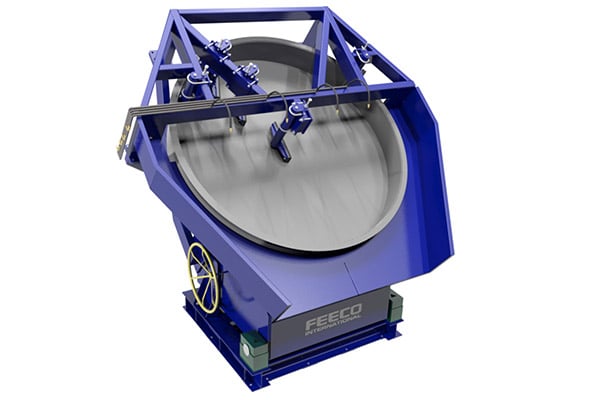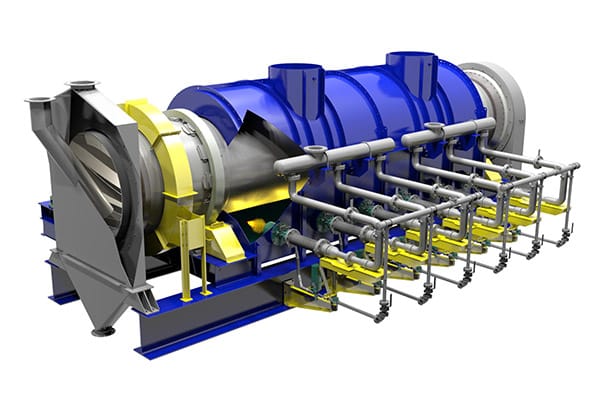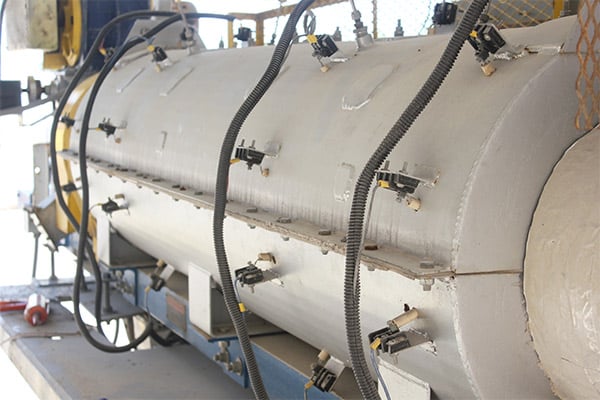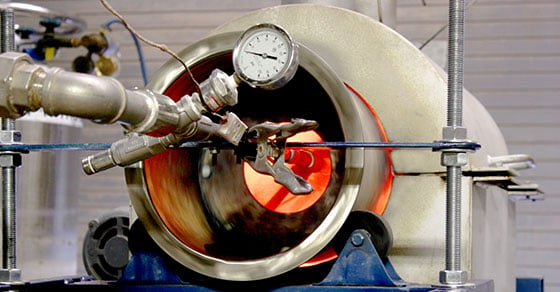As the role of catalysts in industry continues to grow, catalyst manufacturing research and development continues to rise. In this effort, the FEECO Innovation Center serves as a critical testing environment for producers looking to improve existing products or develop new ones.
The following looks at the factors pushing demand for this type of work, as well as the capabilities the Innovation Center lends to catalyst manufacturers.
Factors Driving Catalyst Demand
Catalysts are an invaluable tool in many industrial processes, helping to facilitate reactions between materials. They are so important in fact, that some experts estimate they are responsible for 85-90% of products in the chemical industry.[¹]
Like many industries, a complex relationship between many factors is responsible for driving the demand for catalysts. Some of these factors include:
Growth in Applications
As such a valuable tool, catalysts continue to see growth in the applications in which they are employed. One sector that is especially suited to demand growth is the use of catalysts in the production of fine chemicals and pharmaceuticals, where catalysts play a critical role in selective synthesis.[²]
The ongoing expansion of developing countries and regions further pushes industrial growth, thereby increasing demand for more catalysts.
One industry in which this is particularly exemplified is petroleum refining – the industry currently responsible for the largest demand on catalysts. Increasing refinery capacity and fuel requirements are driving an increase in demand growth.[³]
Increased Focus on Sustainability
An increased focus on sustainability has prompted a surge in environmental regulation and efforts to curb environmental risks, fostering a growing demand for catalysts that can be used in such applications. This is especially true in reducing contaminants in refinery products.[²]
Whether preparing CO2 for use or sequestration, removing volatile organic compounds (VOCs) in air pollution control efforts, or aiding in efforts to develop alternatives to fossil fuels, catalysts have become a key tool in environmental protection, with a wide range of applications in the field.
Advancing Production and Technology
The importance of reducing costs, maximizing efficiency, and improving end products continues to be a central focus in many industries employing catalysts.
As a critical tool in improving reactions, catalysts play a vital role in this endeavor, whether producing more effective products and materials, or maximizing the efficiency of reactions.
R&D Around Catalyst Production
The catalyst industry is extremely diverse; in addition to optimizing existing catalysts, producers are constantly looking to develop new catalyst products with precise characteristics to meet the exact needs of a given application.
According to the Rutgers Catalyst Manufacturing Science and Engineering Consortium[4], catalyst production has historically not seen a focus in the academic world, leading to sub-par catalyst design and manufacturing and emphasizing the need for further exploration.
Further, various physical and chemical properties of catalysts can be adjusted and fine-tuned to produce a product that will be optimized for its intended application, yielding hundreds of possibilities and potential outcomes.
For these reasons, research and development around manufacturing better catalyst products has gained an increasing amount of attention.
Depending on the type of catalyst, there are several key aspects to the success of a product, each with a significant influence on the performance, reliability, and longevity of the product:
- Formulation
- Agglomeration
- Impregnation
- Drying
- Calcination
Formulation:
Catalysts are made up of a variety of materials and combinations of such in order to suit the intended application.
Formulation often focuses on reducing/minimizing emissions, optimizing the intended reaction, maximizing re-usability, and mitigating the production of any potential byproducts. Zeolites and alumina are frequently utilized catalyst supports/substrates.
Catalyst formulation is a highly proprietary endeavor. Once catalyst formulations have been established, testing can begin on creating the catalyst product itself.
Agglomeration
Agglomeration, or particle size enlargement of a catalyst powder, and more often a catalyst support, serves many purposes.
Agglomeration is widely used to produce larger support materials onto which active catalytic components can be effectively overlaid, with different approaches to agglomeration available.
The use of wet granulation or pelletizing to produce a rounded granule has become increasingly popular, for the many benefits this form can offer, including improved heat transfer during calcination, minimal attrition, impregnation advantages, and more.
Agglomeration of a catalyst can be a highly customizable endeavor; characteristics such as particle size distribution, mechanical strength, shape, and more, can all be fine-tuned during the agglomeration process to meet exacting specifications.
The Innovation Center offers testing around wet granulation, with the most common approach consisting of a pin mixer and disc pelletizer combination.
Testing is critical to determine the ideal equipment selection and work out the many process variables in order to produce a product with the intended characteristics.

3D Model of a FEECO Disc Pelletizer
Agglomeration is often likened to a blend of science and art; it takes an experienced hand to consistently produce a product with the target qualities. Agglomerate characteristics that are most often targeted when producing a catalyst product include:
- Particle size distribution
- Mechanical strength
- Shape
- Attrition
- Bulk density
- Ability to “hold up” in a rotary kiln
- Surface area
- Packing density
- Bed permeability
The factors below can all be used during the agglomeration process to influence the end product characteristic of the catalyst granules:
- Equipment choice
- Binder formulation
- Binder feed rate
- Material feed rate and location
- Pan speed
- Pan angle
- And more…
Impregnation
Impregnation refers to the loading of the active catalyst component onto a solid support material to achieve the desired catalytic activity. This is often achieved through incipient wetness impregnation, in which the catalytic component is made into a solvent, which is then sprayed over the solid material, typically in a rotary drum (referred to as an impregnator in this setting).
As with agglomeration, several factors play into reaching the desired process and product objectives. This might include:
- Drum size (diameter and length)
- Solid feed rate
- Spray rate and concentration
- Location and number of sprays, as well as nozzle type(s)
- Temperature of spray
- Drum speed and slope
- Retention time
- Design of internals
- Bed depth (percent fill)
The Innovation Center employs a rotary coating drum for testing the impregnation process, allowing producers to work out these variables and establish data necessary for process scale-up.
Drying
Following impregnation (or agglomeration, if an impregnation step is not used), the material requires drying. Historically, the drying step has been largely overlooked, but in recent years researchers have discovered it plays a more critical role in the characteristics of the final product than initially thought. This has put increased attention on the drying process and its many parameters.
Testing typically centers around establishing the following:
- Drum size
- Solid feed rate
- Retention time
- Temperature profiles
- Drum slope and speed
- Air flow velocity
- Inlet and outlet moisture
- Material flowability
The Innovation Center utilizes a pilot-scale rotary dryer to assist catalyst manufacturers in establishing the best parameters for their unique product and process goals.
Calcination (Curing)
Upon drying, the catalyst undergoes calcination, which carries out several finishing objectives, including pore structure finalization, removal of crystalline water, and more.
Calcination is most often carried out in an indirect-fired rotary kiln (also referred to as a calciner), which utilizes contact with the shell of the drum to pass heat to the material within (this is in contrast to direct-fired kilns, which utilize direct contact between the material and combustion gas to heat material to the required temperature).

3D Model of a FEECO Indirect-Fired Kiln (Calciner)
Again, the desired characteristics of the finished catalyst product are influenced by finding the right combination of process variables, including:
- Residence/Retention time
- Temperature profiles
- Internal kiln atmosphere
- Rotational speed
- Drum slope
- And more….
This type of high-temperature thermal processing is a highly technical endeavor, requiring significant expertise in advanced thermal processing techniques.
All of these factors in formulation, agglomeration, impregnation, drying, and calcination combine to influence the overall performance, longevity, and efficiency of the end catalyst product.
The FEECO Innovation Center
As can be seen, process and product development around catalysts is paramount to producing a product that performs as desired. While there may be a variety of testing facilities on the market, none offer the advantage that the FEECO Innovation Center does: the Innovation Center can accommodate the various testing methods individually, as well as in continuous process loops, integrating multiple aspects of the process. This provides a “one stop shop” for catalyst manufacturers looking to optimize an existing catalyst, or develop a new one. Staffed by experienced process engineers, the Innovation Center is equipped with everything needed to work out the intricacies of each process component, as well as how they will combine as a continuous process to create the desired product.
Further, the test work carried out in the Innovation Center is invaluable to scaling up such processes to build a commercial-scale operation. This reduces risk in the commercialization process and provides producers with the confidence of a well-developed catalyst.

FEECO Indirect Pilot Kiln used for testing in the Innovation Center
Conclusion
As the demand for catalysts continues to rise across diverse industrial sectors, the role of robust research and development in catalyst manufacturing becomes increasingly critical. The FEECO Innovation Center stands at the forefront of this effort, offering a unique environment where producers can refine existing products and innovate new ones. By providing comprehensive testing capabilities, the Innovation Center not only addresses current industry challenges but also pioneers advancements that drive efficiency, sustainability, and product performance. As catalyst applications expand and evolve, the Innovation Center remains a pivotal partner for manufacturers seeking to achieve optimal outcomes in catalyst development and production. FEECO uses the data gathered to engineer and manufacture the custom equipment required for the job.
For more information on testing in the FEECO Innovation Center, contact us today!
SOURCES:
- Wiley-VCH. (2007). Introduction to Catalysis. In Concepts of Modern Catalysis and Kinetics.
- Fillmore, D. (2002) Catalysts Rising. Today’s Chemist at Work. American Chemical Society.
- Industrial Catalyst Market – Growing Manufacturing Industries & Increasing R&D Driving Growth. (2016, February 26). PR Newswire. Retrieved October 3, 2024, from https://www.prnewswire.com/news-releases/industrial-catalyst-market—growing-manufacturing-industries–increasing-rd-driving-growth-300226830.html.
- Rutgers University. (n.d.). Rutgers Catalyst Manufacturing Consortium Brochure. https://coewww.rutgers.edu/bglasser/catalyst/Rutgers-Catalyst-Manufacturing-Brochure.pdf



